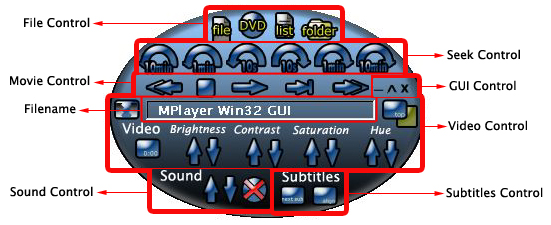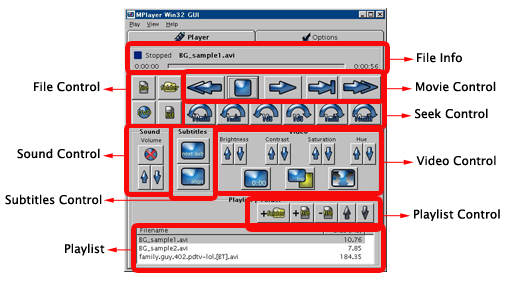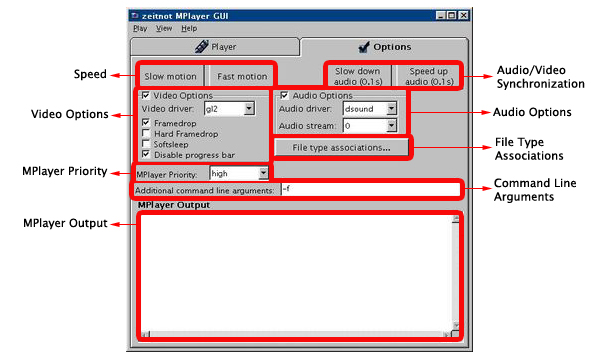File Control: | Movie Control: |
Seek Control: | File Info: |
- Open a file.
- Open a folder.
- Open a DVD.
- Open the playlist.
|
- Play previous file in the playlist.
- Stop.
- Play / Pause.
- Next frame.
- Play next file in the playlist.
|
- Seek back 10 minutes.
- Seek back 1 minute.
- Seek back 10 seconds.
- Seek forward 10 seconds.
- Seek forward 1 minute.
- Seek forward 10 minutes.
|
- MPlayer state (stopped/playing/paused).
- File name.
- Play position.
- Play progress bar.
- File length.
|
|
Sound Control: | Subtitles Control: |
Video Control: | Playlist Control: |
- Mute.
- Volume up.
- Volume down.
|
- Subtitles on/off/next.
- Subtitle alignment.
|
- Adjust brightness.
- Adjust contrast.
- Adjust saturation.
- Adjust hue.
- On screen display.
- Video window stay on top.
- Video fullscreen.
|
- Add a folder.
- Add a file.
- Remove the selected file(s).
- Move file up.
- Move file down.
|
|
Speed: |
Video Options: |
Audio Options: |
- Slow motion: Plays at half the speed.
- Fast motion: Plays double speed.
|
- Video driver:
Select a video driver from these ones:
- directx (default) -> DirectX driver. Video is in a standard window.
- gl2 -> OpenGL driver. Video is borderless.
- winvidix -> VIDIX driver. Will likely crash.
- Framedrop (default on): Skip displaying some frames to maintain A/V sync on slow systems.
- Hard Framedrop: More intense frame dropping. Leads to image distortion!
- Softsleep: Use high-quality software timers instead of the RTC.
As precise as the RTC without requiring special privileges.
Comes at the price of higher CPU consumption.
|
- Audio driver:
Select an audio driver from these ones:
- dsound (default) -> DirectX DirectSound audio output driver.
- win32 -> native Windows waveout audio output driver.
- Audio stream: Select an audio channel.
|
Audio/Video Synchronization: |
- Slow down audio by 0.1 second.
- Speed up audio by 0.1 second.
|
|
MPlayer Priority: | File Type Associations: | MPlayer Output: |
Set process priority for MPlayer according to Windows predefined priorities:
- idle
- belownormal
- normal -> Default.
- abovenormal
- high
- realtime -> This setting will cause a system lockup... eventually.
|
- File type associations...
This will open the File Type window. You can check and unchecked the file type you would like to be associate with the zeitnot MPlayer GUI.
| This is the console output of MPlayer (stdout and stderr).
Look in this window for clues when having trouble playing a particular file. You can
press ctrl+a in this text box to select the entire output to copy and paste in your favourite program.
| |
Command Line Arguments: |
- Additional command line arguments: This is where you can add some command line arguments.
|
|



